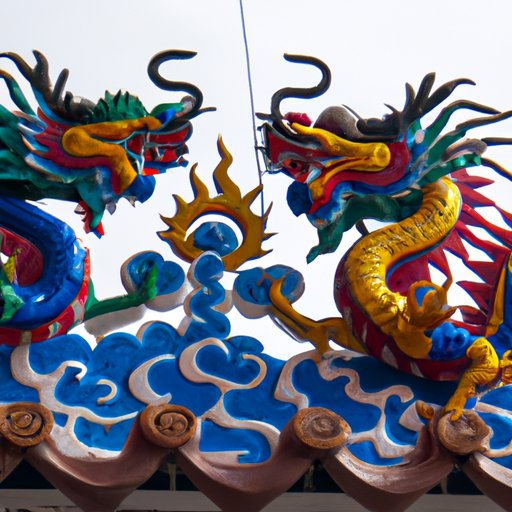Introduction
Dragons have been a prominent symbol in Chinese culture for centuries, with a rich history and deep-rooted symbolism. The dragon is an important part of Chinese mythology, folklore, art, literature, and modern media, and continues to play an influential role in contemporary Chinese society. But what exactly is a dragon, and why are they so important in Chinese culture?
Exploring the History of Dragons in Chinese Culture
The Chinese dragon is a mythical creature that dates back to ancient times. It is typically depicted as a large, serpentine creature with four legs, horns, and a long tail. Its body is often covered in scales and its eyes are said to be able to see into the future. The dragon has been a popular symbol in Chinese culture since at least the Shang Dynasty (1766–1122 BCE).
During this period, the dragon was closely associated with the emperor and was seen as a symbol of power and strength. Over time, the symbolism of the dragon evolved and began to represent good fortune, success, and prosperity. By the Han Dynasty (206 BCE–220 CE), the dragon had become an important symbol of imperial authority and was featured prominently in art and literature.

Examining the Symbolism and Significance of Dragons in Chinese Folklore
In Chinese folklore, the dragon is widely regarded as a powerful and auspicious creature. It is believed to bring rain and fertility to the land, and is often associated with natural elements such as water, fire, and wind. The dragon is also thought to possess great wisdom and knowledge, and is seen as a symbol of good luck and fortune. It is believed that those who possess the power of the dragon will be blessed with wealth and success.
The dragon is also a symbol of strength and courage. In traditional Chinese martial arts, the dragon is often invoked as a source of power and resilience. It is believed that by drawing on the dragon’s strength, one can become invincible in battle. To this day, the dragon remains a popular symbol of power and strength in China.

Investigating the Role of Dragons in Traditional Chinese Art and Literature
Throughout history, dragons have played a prominent role in Chinese art and literature. In traditional Chinese mythology and folklore, dragons are often depicted as benevolent creatures that help humans in times of need. They are also commonly featured in paintings and sculptures as symbols of power and prosperity. In novels and poems, dragons are often used as metaphors for strength, courage, and wisdom.
In addition, dragons are often used to represent certain virtues or values. For example, the dragon is often used to signify courage and strength in the face of adversity. In other cases, the dragon can be used to represent ambition and perseverance, or to signify the importance of family and community.
Analyzing the Representation of Dragons in Modern Chinese Media
In recent years, dragons have become increasingly prominent in modern Chinese media. Films and television shows often feature dragons as powerful and wise creatures that help the protagonists achieve their goals. Digital art and animation often depict dragons as majestic and awe-inspiring creatures. Finally, dragons are commonly featured in video games as powerful enemies or allies.
The representation of dragons in modern Chinese media has helped to preserve the cultural heritage of the dragon and ensure that it remains relevant in contemporary Chinese society. By featuring dragons in popular media, filmmakers and game developers have helped to keep the dragon alive in the minds of modern audiences.

Understanding the Impact of Dragons on Contemporary Chinese Society
Today, dragons remain an important symbol in Chinese culture. They continue to influence popular culture, appearing in films, television shows, video games, and digital art. In addition, dragons continue to play an important role in business and politics. Many businesses in China have adopted the dragon as their mascot or logo, while politicians often use dragons as symbols of power and strength.
The dragon is also an important symbol of cultural heritage in China. Despite the changing face of modern Chinese society, the dragon remains an important part of the country’s identity. By preserving the symbolism of the dragon, Chinese people are able to honor their cultural heritage and ensure that it is not forgotten.
Conclusion
For centuries, dragons have been an important part of Chinese culture and folklore. From ancient origins to modern media, the dragon has been a symbol of power and strength, good fortune, and cultural heritage. Today, the dragon continues to play an influential role in Chinese society, appearing in art, literature, film, television, and video games. As long as the dragon remains an important symbol in Chinese culture, it will continue to be revered and celebrated by generations to come.
(Note: Is this article not meeting your expectations? Do you have knowledge or insights to share? Unlock new opportunities and expand your reach by joining our authors team. Click Registration to join us and share your expertise with our readers.)
